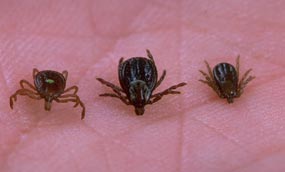Main Content
Article
Ticks

Ticks
It's a beautiful late spring/early summer day with the sun shining; the overall perfect day to enjoy the great outdoors. You pack up the car with some snacks, drinks, binoculars, all of your usual hiking gear, and of course your family or some friends and head to your favorite Indiana park or reservoir to enjoy a nice worry free day of hiking through the woods. Everything is going great until…someone in your group feels a slight tickle of tiny legs crawling up their arm. What could it be?….a tick!!! You've all had that experience, where one person spots a tick crawling on them and you end up feeling all "bugged out" and the rest of your trip is spent worrying, searching, swatting, and swearing that there's a tick crawling on and perhaps biting you too.
We've all had that feeling, but to say we're all "bugged out" by ticks isn't quite right. Ticks aren't bugs (or insects) at all! Ticks are different in several ways. Ticks have two body parts and eight legs, where insects have three body parts and six legs. There are many species of ticks in Indiana, but the three most common ones are the American dog tick, lone star tick, and black-legged tick and all of these are usually pretty harmless to people.
The American dog tick is the most common of the three. This large slow moving tick is usually gray to dark brown in color. Perhaps this tick earned its name from its favorite food host….your dog! The larva of this tick prefers wild mammals or your pets to feed on. However, the adult will use its short mouth to feed on us as well! The second most common tick is the lone star tick, aka the seed tick, turkey tick, or deer tick. It may be smaller than the American dog tick, but with its longer mouth it sure has a bigger bite! The female is easily recognized by the white spot on the center of her back…the lone star maybe?! The black-legged tick was established in Indiana in 1987 and quickly became the most feared. This tiny mahogany colored oval is know for carrying Lyme disease that most of us are worried about getting from tick bites. In reality, the black-legged tick would rather feed upon mice, small rodents and white tailed deer.
Indiana ticks may carry two other diseases besides Lyme disease. The two other most common diseases are Mountain Spotted Fever and Ehrlichiosis. Symptoms for these three diseases range from spreading rashes, headaches, fatigue, fevers, to muscle aches. Although your chances of contracting these diseases are pretty rare, if you are bitten the best action to take is to remove the tick, save it and label it in a jar in case symptoms develop.
You may be thinking "There's no way I'm hiking now!" But remember…the chances of contracting one of those diseases are pretty slim and there are precautions to take to protect against being bitten. All you need to do is to follow these four easy suggestions: wear long pants and long sleeved shirts, tuck shirts into pants and pants into socks, use insect repellant, and always check for ticks when you leave the woods.
So load up your car and bring along your friends on the next warm and sunny day to enjoy a day of hiking. Be prepared, and don't worry about feeling "bugged out" by ticks!
